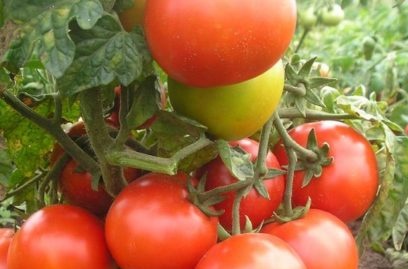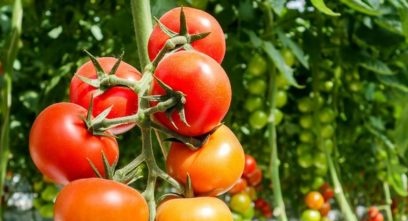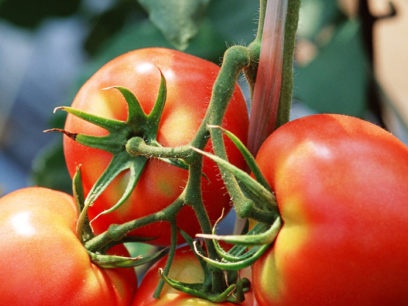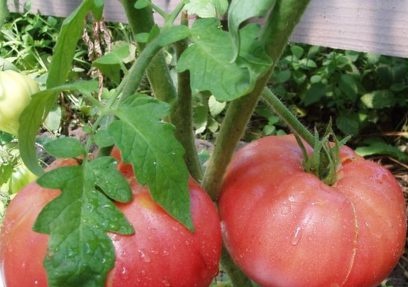Tomato - beloved by many annual or large species of plants, which belongs to the Solanaceae family. Its fruits are unique - they can be red, yellow, pink or orange. They can be planted in open ground, in a greenhouse and expected to harvest in August and September, depending on a particular variety. You can eat tomatoes fresh, in salads, in lecho, vegetable stew, salted and pickled. Due to this diversity, many people love this vegetable for its variability of cultivation and taste palette of varieties.
Content
Selection of a Determinant Variety
When choosing determinant varieties of tomatoes, you can focus not only on the ripening period, for example, early ripening, but also for which areas they are intended - southern or northern:
- Southern species have great climatic stability, which allows protecting fruits and leaves from direct sunlight. They have a long growing season and dense foliage.
- The northern ones are intended for a short hot period, their leaves are arranged in such a way as to open the fruit to the sun. In the southern regions, they will die, or even if they grow, the tomatoes on them will be damaged.
Classification of fruit ripening
Determinant tomato varieties differ in terms of achieving technical maturity. Allocate:
- ultra-early;
- early ripe;
- mid-season.
To be sure, in harvesting, it is recommended to plant early-ripe and ultra-early varieties.

Landing Features
It is important to carefully consider the selection of tomato varieties for planting, as some of them bear fruit well in the open, while others need warmth and protection. The following categories of tomatoes are distinguished.
Undersized
Unpretentious in cultivation. Suitable for the northern and central strip of Russia.
Flowering begins after the 5th leaf on the trunk, and growth ends with the last inflorescence. The main varieties of undersized tomatoes:
- Antoshka. Early ripening, ripens in about 95-100 days, yield is 5-5.5 kg per square meter. Fruits are yellow, rounded, small, with soft pulp. Suitable for salads and salting.
- Watercolor. Early ripening, ripens in about 95-100 days, yield is 4-4.5 kg per square meter. Large enough, red fruits, oval. With soft pulp and a slight acidity.
- Krakowyak. Early ripening, ripens in about 75 - 80 days, yield is 1.5 kg from one bush. Squared red fruits, medium in size, quite resistant to disease and are great for salads.
Tall tomatoes
They are difficult enough to grow. They are susceptible to diseases and require additional care, but please with their productivity and long fruiting.

Popular varieties:
- Barmaley. Early ripening, ripens in about 95-100 days, yield is 12 - 16 kg per square meter. Squared pink fruits, larger than 200 grams, fleshy and suitable for salads.
- Bogatyr Maslova. Mid-ripening, ripens in 115-125 days, the yield is 10-12 kg per square meter. Round, red fruits.
- The giant is lemon.Early ripening, ripens in about 120 - 140 days, yield is 12 - 15 kg per square meter. Flat-round bright yellow fruits, larger than 700 grams, fleshy and universal.

Hybrid forms of tomatoes
Features agrotechnology hybrid varieties are required. Determinant hybrids have shown themselves well in industrial cultivation, as they show the maximum yield when using hydroponics. Private households rarely use these techniques.
There are certain features of growing seedlings, which include the use of a peat-sand mixture for sowing it.
Popular hybrid varieties:
- Townsville F1. Early ripening with a growing season of 67 days, the yield is 7-10 kg per square meter. Rounded red fruits weighing up to 200 grams. Bushes - tall, requiring tying. In open ground they can grow in southern and central Russia, to the north - greenhouses are required.
- Polonaise F1. An early determinant hybrid variety. Ripens in 60-70 days, after the seedlings are planted in the ground (it is recommended to plant in the south in open ground). Fruits are saturated red with juicy flesh. resistant to disease and transportation.
- Polbig F1. Ultra-early variety of tomatoes, ripening occurs 55 days after planting. Resistant to low temperatures, can be grown everywhere. Productivity per square meter can reach 20 kg. Tomatoes are red, roundish, medium size - 150-200 grams. The variety is universal. Suitable for salads and preserves.
- Torbay F1. Technical maturity occurs after 65 days, is an early ripe Dutch hybrid. The height of the bushes in the greenhouse can reach 1.5 meters. Fruits are roundish, small (150-200 grams) pink, have a sour - sweet taste. Productivity of 18-20 kg per square meter. The variety is universal, used for winter harvesting, fresh salads and vegetable mixes.

Necessary conditions for tomato yield
To form a large and high-quality crop, tomatoes require additional nutrition, which they naturally receive from soil and fertilizers. Elements for a healthy harvest:
- Phosphorus. It is recommended to use from the first days of planting, you can put in the holes in which seedlings will be planted, after sprinkling a small amount of earth, in order to avoid direct contact of the roots of tomatoes and phosphorus. Fertilizer stimulates the growth of vegetables and at times can increase frost resistance. Phosphorus must be added to all top dressings, because thanks to it other fertilizers “work” better.
- Potassium. It is recommended to use together with phosphorus and also add to the wells when planting. A combination of phosphorus and potassium, in addition to increasing frost resistance, accelerates the ripening of tomatoes and affects the yield. If potassium is not enough - the tomatoes will lag behind in growth, ripen not evenly, and even the appearance of spots on the fruits is possible.
- Nitrogen. It is the most important, as it is responsible for the growth and ovary of tomatoes. It is recommended that you make it several times in the mail at regular intervals, with a lack of nitrogen, the leaves turn yellow, dying off and there is no question of any crop.
Choosing a tomato variety is not difficult. To do this, you need to study information from the manufacturer. It is indicated on a bag of seeds. But this is only a small part of success. When growing crops, it is necessary to observe the conditions of planting, to properly care for the plant, to protect it from pests.

 Low-growing tomatoes, without pinching: 5 of the most delicious varieties
Low-growing tomatoes, without pinching: 5 of the most delicious varieties Why tomato seedlings grow poorly
Why tomato seedlings grow poorly We grow a tomato in a shell
We grow a tomato in a shell Growing tomatoes without watering according to the method of Kazarin
Growing tomatoes without watering according to the method of Kazarin